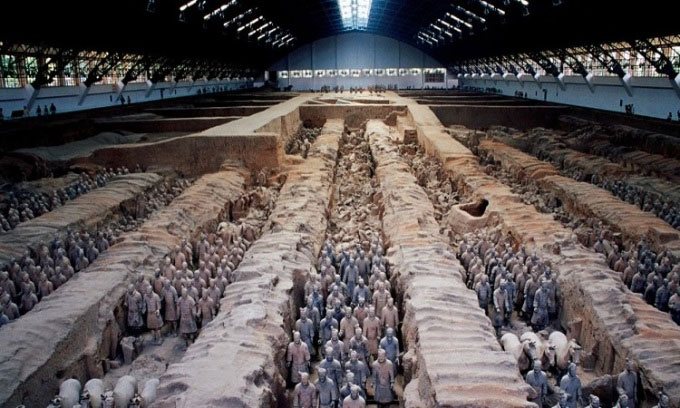Cosmic rays could help archaeologists locate the secret tomb containing the remains and treasures of Qin Shi Huang, the first emperor of China.
The tomb of Qin Shi Huang in Xi’an, Shaanxi, was built by hundreds of thousands of laborers over nearly four decades and was completed around 208 BC, according to the Han historian Sima Qian. Covering an area 70 times larger than the Forbidden City, it is the largest personal tomb in the world. The surface structures of the tomb have not survived after thousands of years, but the underground structures remain largely intact. Some archaeologists believe that the central burial chamber, which contains the emperor’s coffin and the most valuable treasures, has not been disturbed, as they found no evidence of breaches indicating tomb robbers had entered the area.

The Terracotta Army in the tomb of Qin Shi Huang in Xi’an. (Photo: National Geographic)
A study funded by the Chinese government to assess the feasibility of a cosmic ray project concluded that at least two cosmic ray detectors need to be positioned about 100 meters above the ground. These large devices, the size of a washing machine, can detect subatomic particles originating from space striking the Earth. Data from the study will allow scientists to identify hidden structures that cannot be observed by other methods with high detail, according to Professor Liu Yuanyuan and colleagues at Beijing Normal University in research published in the journal Acta Physica Sinica of the Chinese Physical Society on December 13.
In the 1970s, researchers discovered over 8,000 terracotta warriors, the army guarding the emperor in the afterlife, in the necropolis, buried in pits far from the center of the tomb. After decades of surveys, archaeologists confirmed the existence of an underground palace over 30 meters high. They also found evidence consistent with Sima Qian’s descriptions of waterways filled with mercury to simulate China’s major river systems and oceans. However, the detailed structure of the palace and the exact location of the tomb containing the emperor’s remains remain a mystery. Other descriptions by Sima Qian, such as traps equipped with bows and arrows aimed at anyone entering the tomb, have yet to be confirmed.
Using cosmic rays in archaeology is a concept dating back to the 1960s. Astrophysicists discovered that cosmic rays collide with molecules in the atmosphere and produce a type of particle called muons, which can penetrate almost anything. Muons are more easily absorbed when passing through dense materials. By comparing the number of muons detected from various angles, the archaeological team can identify hollow structures such as hidden tombs or passages within buildings. However, this idea remains largely theoretical because muons are not easy to detect. For decades, scientists had to rely on bulky equipment the size of a room, making practical application challenging.
In recent years, thanks to advancements in particle physics, the size of cosmic ray detectors has significantly decreased. In 2017, an archaeological team in Egypt discovered a 30-meter-long tomb inside a pyramid by using portable detection equipment.
Yang Dikun, an assistant professor of geophysics at the Southern University of Science and Technology in Shenzhen, believes the project is feasible. According to Yang, archaeologists have attempted to map the tomb using other methods. Gravity anomaly detectors can detect materials with different densities but are limited to a small area, and their accuracy can be affected by environmental noise. Electromagnetic signals are most sensitive to structures containing metals, and ground-penetrating radar is limited in depth.
However, the method using cosmic rays also comes with several challenges. Detectors must be placed at appropriate depths without affecting the structures or artifacts above. Unlike detection methods that can yield results almost immediately, muon detectors must operate on-site long enough to collect sufficient particles for analysis. Computer simulations conducted by Liu’s team indicate that it would take a year to gather enough data to produce clear images.
- Why do the concubines who were buried alive with Qin Shi Huang not close their legs after being buried?
- Why did a German expert claim “this place cannot be excavated” after scanning the tomb of Qin Shi Huang with MRI?
- A coal mine burning for 300 years, “lightly burning” 1 billion yuan each year, yet China is still powerless!


















































